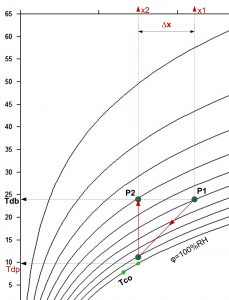When dehumidifying (drying) the air, the absolute water content x in the air (absolute humidity) decreases. We achieve this in different ways: in this case by cooling.
The wet air is brought into contact with a surface whose temperature is lower than the dew point temperature Tdp of the dehumidified air. Some of the water vapor condenses on this surface, thereby reducing the water vapor content of the air. The state change in the h-x diagram is represented by a line running from the point of the initial state of the air P1 to the intersection of the mean temperature of the cooling surface Tco with the saturation curve.
The amount of condensed water depends on the cooling capacity supplied. The water vapor content decreases by Δx, while the relative humidity of the air increases. With this method of dehumidification, the air always cools down, so the air must be reheated. This will also reduce its relative humidity RH.

